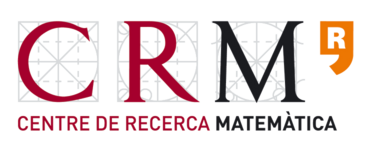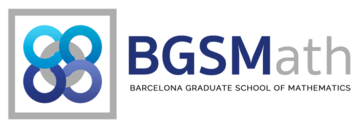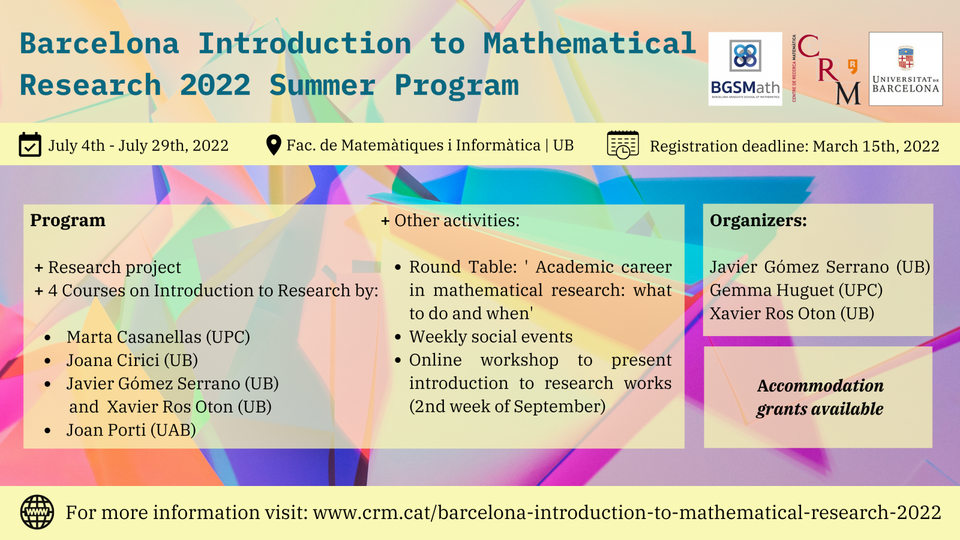Barcelona Introduction to Mathematical Research 2022 Summer Program
Sign into July 29, 2022
LOCATION:
Aula T1 de la Facultat de Matemàtiques i Informàtica, Edifici Històric UB.
SCHEDULE
This will be the first ‘Barcelona Introduction to Mathematical Research’ Summer Program organized by CRM-UB with professors from UB-UAB-UPC-CRM, which aims to attract students in Mathematics (mainly in their 3rd or 4th year) from any university (in Barcelona or elsewhere).
The program will consist of a research project, four minicourses and other activities.
The students will work on a research project in Mathematics during the month of July 2022.
This will be done under the supervision of a senior Advisor, and will consist of reading one or a few research papers (or book chapters) and/or working on a small open problem.
A committee will assign the students to their senior Advisors based on the preferences of both.
Here you have the list of Advisors and projects.
The students will participate in four courses on Introduction to Research, given by:
- Marta Casanellas (UPC, Algebraic Methods in Phylogenetics)
- Joana Cirici (UB, Topology of Complex Manifolds)
- Javier Gómez Serrano and Xavier Ros Oton (UB, Analysis and PDE)
- Joan Porti (UAB, Geometry)
Each of these courses will be 5h long, and will take place at Facultat de Matemàtiques i Informàtica de la Universitat de Barcelona.
STUDENT PRESENTATIONS
Tuesday, September 6
15:30 – 16:30 | Oriol Baeza, Matías Viner, Joaquim Duran
16:30 – 16:50 | BREAK
16:50 – 17:30 | Gerard Castro, Albert Alcalde
Wednesday, September 7
15:30 – 16:30 | Roger Garrido, Jorge Rodríguez, Francesc Pedret
16:30 – 16:50 | BREAK
16:50 – 17:50 | Pau Cantos, Alejandro García, Abel Doñate
Thursday, September 8
15:30 – 16:30 | Carla Nova, David Muñoz, Joana Pech
16:30 – 16:50 | BREAK
16:50 – 17:30 | Victor Bigorra, Aleix Torres, Sergio Romero
The students will participate in the following activities:
- Round Table: ‘Academic career in mathematical research: what to do and when’.
- Weekly social events: coffee breaks during the minicourses, and a social pizza evening each week of July.
- Online Workshop: ‘Barcelona Introduction to Research 2022’ where the students will present their introduction to research works. It will take place during the second week of September.
The selection of applicants will be done based on:
- Expression of interest.
- CV.
- Academic transcript.
- Two recommendation letters.
The expected number of students is around 15 participants.
-
- Click here to access the questionnaire for students to apply for participation. Please, send your CV, motivation letter and academic transcript (PDF) by email to summerprogram@crm.cat (indicating your full name in the subject).
- Click here to access the form for Professors. Please, send the student reference letter (PDF) by email to summerprogram@crm.cat (indicating the student name in the subject).
Application deadline: 15th March 2022.
Resolutions: will be sent by April 1st if the number of applications allows it.
Summer Program: July 1st – July 29th.
Online workshop to present research: second week of September.
ACKNOWLEDGEMENTS



Abel Doñate
Title: Coxeter Matroids
Abstract: Matroids are a very recent object of study in the field of combinatorics. In this lecture we will make an introduction to them and focus on a subdivision of them that is closely related with Coxeter Groups: Coxeter Matroids.
Pau Cantos & Alejandro García
Title: The Kirby’s torus trick for surfaces
Abstract: The classification up to homeomorphism of compact connected surfaces was one of the landmarks of topology in the first decades of the XX century. It is usually taught in math degrees, but most of the time an important step, the triangulability of compact surfaces (Rado’s theorem) [1], is taken for granted without proof. Here we have studied an alternative: to prove the equivalence between the classification of topological and smooth surfaces, so that the topological one can be thought of as a corollary of the smooth one and vice versa. This is explained in Hatcher’s paper [2] using Kirby’s torus trick, which is a basic tool in the study of topological manifolds, especially in higher dimensions.
[1] T. Radó, Über den Begriff der Riemannschen Fläche, Acta Sci. Math. Szeged. 2 (1925), 101-121.
[2] Allen Hatcher. “The Kirby torus trick for surfaces”. In: arXiv preprint arXiv:1312.3518 (2013).
Victor Bigorra
Title: On Arnold’s proof of the instability of the dynamical system of a chain of transition toruses under unstable motion
Abstract: The main goal of this research will be to go throughout the proofs of Theorem 3 and Lemma 1 from V.I. Arnol’d paper “Instability of dynamical systems with several Degrees of freedom” (1964), making explicit some of the calculations and steps of the proof and complementing it with some considerations on the parameter range, the amount of toruses and going to infinite frequencies.
Jorge Rodríguez
Title: On Salmon’s computation of the flex polynomial.
Abstract: We are all familiar with inflection points of a real function. However, this concept can also be studied on arbitrary algebraic varieties. The aim of the talk is to obtain an equation describing the inflection points of an algebraic surface in the projective space. For this purpose, we will interpret and modernise the calculations that the mathematician George Salmon (1819-1904) carried out a century and a half ago.
Albert Alcalde
Title: Delay formulation of a structured population model
Abstract: In this brief presentation, we use the Method of characteristics to go from the PDE formulation to the delay formulation for a mathematical model belonging to the field of size-structured population dynamics. Establishing such connection ensures some desirable properties of the model, such as the existence of a linearization Theorem.
Oriol Baeza
Title: An uncertainty principle for polynomials
Abstract: In the work of Donoho and Stark, they study a manifestation of the uncertainty principle in signal recovery. They prove the infinitesimal case of a conjecture about how the maximum concentration in the low frequencies for the Fourier transform of a support limited function is achieved when the support is an interval.
We study an analogous finite dimensional version of the problem by considering the concentration of polynomials on subsets of the unit circle. We prove an equivalent conjecture also for the infinitesimal case: for a fixed degree of the polynomial and measure of the set, the most efficient choice is an interval.
The techniques used in the problem by Donoho and Stark rely on symmetric rearrangements and an inequality by Riesz. In contrast, for our case we rely solely on an inequality using the concavity/convexity of the sine function. Lastly, we also study the symmetric problem and state some properties about the extremal polynomials.
Carla Nova
Title: ESTIMATION OF MARKOV MATRICES IN TERMS OF BRANCH LENGTH AND ALIGNMENT LENGTH
Abstract: Continuous time-homogeneous Markov processes are frequently used to describe nucleotide sequence substitutions. A different approach arises when time is not considered at all, and any Markov matrix is susceptible to be used to model such substitution processes. From a theoretical perspective, the connection between both approaches leads to the Embedding problem (Elfving, 1937). However, from a more applied point of view, one may be more interested in checking whether the continuous-time approach and the resulting embeddable matrices are enough to properly model the nucleotide substitution processes arising from real data. This project attempts to bring some light to this kind of questions by studying the geometric distance between prescribed Markov matrices and estimations of these matrices obtained from alignments of nucleotide sequences. To ease the computations required, we have focused on the particular case of the Kimura model with 3 parameters (Kimura, 1981) and have paid special attention to the length of the alignment and the branch length of the matrices simulated, which accounts to the expected number of substitutions along the process. All the code necessary to perform the computations has been programmed from scratch in Python language.
Roger Garrido
Títol: Braid monodromy.
Abstract: Braid monodromy is an invariant of complex algebraic varieties and can be computed by integrating an ordinary differential equation. We develop programs to compute this invariant numerically. These computations can be used to determine whether a complex algebraic variety (given by the vanishing set of a single polinomial) is irreducible or not, and otherwise compute some other related invariants.
Joana Pech
Title: Control Optimisation under ODE constraints in the linear parachute problem
Abstract: Control optimisation aims to find a function u(t) of a dynamical system, described with an Ordinary Differential Equation (ODE), such that an objective function is optimised. In this project we consider a skydiver who drops from a helicopter and falls towards the Earth under the influence of gravity. The parachute has an engine to control its speed, and the objective function measures the difference of the speed with respect to a target value, while also penalises very large values of the engine force (u(t)). The optimal conditions of the problem are given by the so-called state, control and adjoint equations, which we discretise in time with standard time-stepping algorithms. We explore solution strategies with low computational cost that solve this aeronautical linear problem with ODE constraints.
Aleix Torres
Title: Lean, the next step in proof formalizing
Abstract: Have you ever wanted to formalize a proof as much as you can? Writing all the details and referring to all the lemmas that you need. Lean is the way to proceed, because it is a programming language that helps mathematicians to write down formal definitions, theorems and their proofs. In this project, with the help of prof. Marc Masdeu from UAB, I introduced myself in Lean’s (and mathlib’s) community, and we decided to collaborate formalizing a proof of the descent theorem in the context of the Mordell-Weil theorem, which is essential in the theory of elliptic curves.
Sergio Romero
Title: From mapping class groups to the boundary at infinity of the hyperbolic plane
Abstract: This presentation is mainly meant to enjoy a short journey throughout the structure
and properties of the mapping class group of a hyperbolic surface. We shall start by recalling the basic ingredients for its various equivalent definitions, namely, isotopy, homotopy and the compact-open topology, and then prove that it is a discrete topological group. Secondly, we will tackle one special case of the Nielsen realization problem, which requires the action of the mapping class group on the Teichmüller space. To conclude, we will visualize the notion of linking at infinity and the induced homeomorphism of the ideal boundary ∂H2 of the hyperbolic plane by an automorphism of the fundamental group of the surface.
Matías Viner
Títol: The moving planes method in Analysis and Geometry
Abstract: In this talk we will give a general idea of the moving planes method in both analysis and geometry. First, we will give a historic overview: where was this method first used and how. Afterwards, we will go into several applications of the method in symmetry problems, free boundary problems and boundary estimates.
Joaquim Duran
Title: Self-adjoint extensions for symmetric operators defined in Hilbert spaces: Von Neumann’s method
Abstract: In quantum mechanics the observables of nature are modelled through operators defined in Hilbert spaces, and the axioms of quantum theory require those operators to have the property of being self-adjoint. In many cases, though, a weaker property is achieved, namely, to be symmetric. Through this project we study von Neumann’s method to find self-adjoint extensions of symmetric operators and apply the method to the observables of momentum and kinetic energy in one dimensional problems.
David Muñoz
Title: On the covering dimension of Cu-semigroups and Cu-morphisms
Abstract: The Cuntz semigroup is a geometric invariant introduced by Cuntz in the 1970s for the study and classification of C*-algebras. The most relevant properties of the Cuntz semigroup can be abstracted to obtain a more algebraic structure, the Cu-semigroup. In this talk, we want to introduce Cu-semigroups and give some context justifying their relevance. Then we will present some background on the recently introduced notion of covering dimension for Cu-semigroups, and hopefully also its generalization to Cu-morphisms, the concept we have tried to define and study during this summer school.
Francesc Pedret
Title: “Analyzing the dynamics of a model of tri-stable perception”
Abstract: Tri-stable perception is a visual phenomenon that occurs in ambiguous images when our perception switches between three different percepts. We analyse a model proposed by P. Ashwin for this phenomenon that generalizes a previous model for 2 percepts, which consists on a four-dimensional dynamical system in which each percept is represented by an equilibrium point. This model has a heteroclinic cycle between the three equilibria. We describe this cycle and analyze the dynamics of the model around it.


